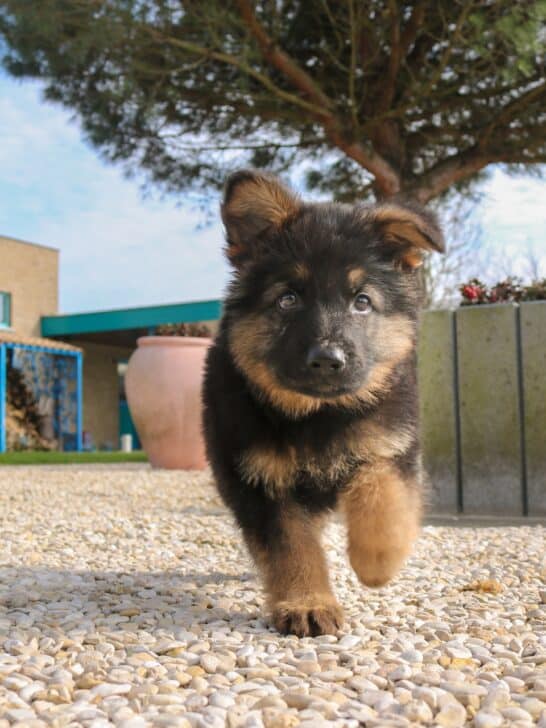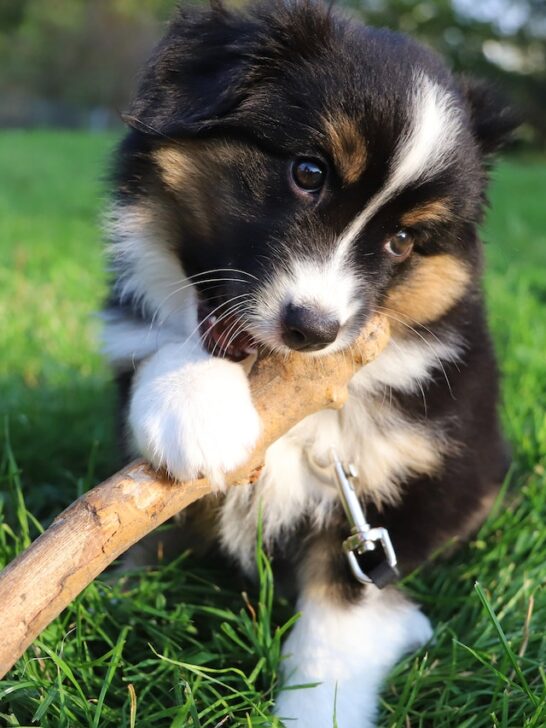German Shepherd Puppy Crying in Crate: What Does It Mean & How to Stop It
Bringing your German Shepherd puppy home is very exciting! It can also be very stressful, and not just for you and your family.
Your new GSD puppy is experiencing life apart from its mom and littermates for the first time. All the smells, sights, and sounds are new. You are new.
It is a lot to take in all at one time.
Sometimes, you may hear your German Shepherd puppy crying in the crate at night or during daytime naps.
What does this mean? What should you do?
The most common reasons why your German Shepherd starts crying include:
- boredom
- hunger
- seeking attention
- fear
- illness
By the time you finish reading this article, you will understand how to address a German Shepherd puppy who is crying while crated.
Should You Crate Train Your German Shepherd Puppy?
If this is the first time you have shared life with a German Shepherd dog, you may wonder if crate training is the right thing to do.
Let us reassure you that this is normal and natural.
But, as Train Your GSD Dog Training points out, it probably isn’t the crate that is causing the crying behavior. It is simply that your puppy is learning how to sleep alone for the first time.
The goal isn’t to do away with the crate. Rather, the goal is to ease the crying and the feeling of being alone for your puppy.
If you can do this, the crate will no longer be an issue.
When to Crate Train Your German Shepherd Puppy
If possible, you want to crate train your German Shepherd puppy starting the first night you bring them home.
Otherwise, you are just putting off the introduction of the crate. And you will likely listen to a crying puppy all night anyway because everything is so new.
Letting your new GSD puppy sleep with you for the first few nights might be tempting. Still, you have to remember your tiny and adorable German Shepherd puppy isn’t going to stay little for long.
According to the American Kennel Club (AKC), adult German Shepherd dogs can easily grow to weigh 90 pounds and stand more than two feet tall!
If the idea of sharing your bed later with an enormous, shedding, snoring canine doesn’t sound appealing, don’t let your little puppy share your bed now.
Persisting with crate training can pay off if you know what to do.
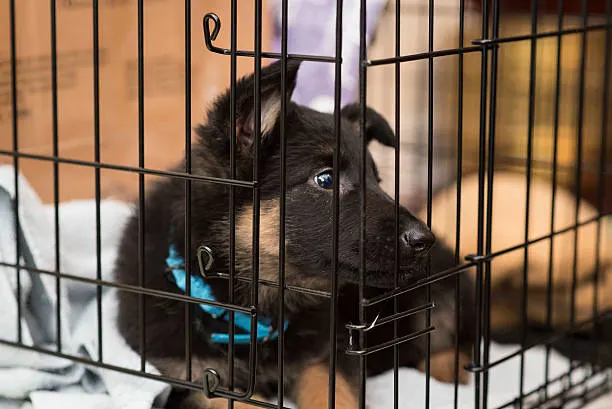
How to Ease Your German Shepherd Puppy’s Crate Fears
Imagine you are a little furry puppy. You are used to sleeping in a huddle with your littermates all snuggled together around your mom.
Suddenly, your sleeping arrangements are changed. Mom is gone.
Your littermates are nowhere to be found. In place of the comfy dog bed (or blanket or whelping bed), there is a cold steel (or plastic) box.
Yuck.
So, the first order of business is to get your new GSD puppy comfy in their new crate!
Here are seven expert tips to make the crate look, feel, and smell homey and safe for your puppy:
- If possible, put something from the puppy’s previous home in a crate. It can be a toy, a blanket, a treat, or something else that smells like “home.”
- Add in something that smells like you that you aren’t attached to, like an old shirt or a pair of socks.
- Make sure your puppy’s crate pad is thick and comfy. It should be moisture-wicking, so any “accidents” don’t leave your pup sitting in a wet crate all night.
- Make sure the crate is roomy enough to give your puppy someplace else to pee and poop if they cannot wait. Remember, it can take up to 12 months for your puppy’s G.I. system to mature fully.
- Place the crate in a cool, dark, quiet place that won’t trigger your puppy’s fears.
- Cover the crate partially for naps and bedtime (but not so much that there is no ventilation). Aim for protecting your puppy from drafts and light while allowing for sufficient airflow.
- Add in a comfortable puppy blanket so your dog can snuggle up in it.
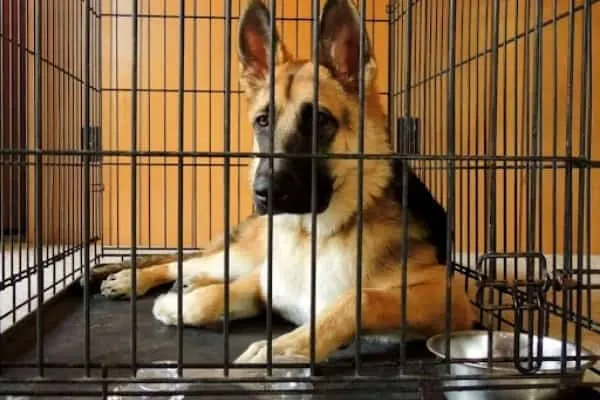
Ease Into Extended Crate Time With Short Training Sessions
When you first bring your German Shepherd puppy home, it may be late in the day, and you may not have time for a bunch of crate sessions right away. As a result, you might have to deal with some whining and crying the first night.
Placing the crate in your bedroom could be helpful. This way, your dog can at least see and smell you.
And if your new GSD puppy needs to potty, which they likely will, you can take care of it right away.
But starting the following morning, you should immediately begin proper crate training for your German Shepherd puppy. And it would be best if you established reasonable expectations for the outcome.
As PetMD points out, even the best crate training in the world may not completely stop your puppy from whining, crying, or barking.
This is because you have chosen an intensely people-oriented dog breed! To some degree, all dogs are oriented towards people, but the German Shepherd dog breed is particularly people-focused.
Your puppy just wants to be with you.
This is why you don’t want to jump into extended crate training sessions. Instead, it’s best to start with very short and sweet sessions to get your German Shepherd puppy used to being in the crate.
Start with 10 or 15 minutes at a time at timed intervals throughout the day. As you do this, make sure the crate is in a quiet place, but not a place that is far away from you and your family.
The more easily your puppy can sense your presence, the less likely they are to get lonely and start crying loudly.
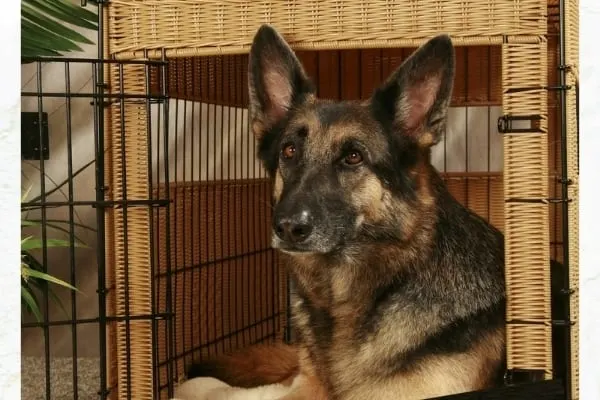
A Sample German Shepherd Puppy Crate Training Schedule
Even under the best of conditions, crate training can be stressful for a puppy. It’s crucial to time your crate training sessions so your German Shepherd puppy doesn’t experience unnecessary extra stress.
This is especially important while your puppy is also going through potty training.
Here is a sample crate training schedule you can adapt to your and your puppy’s needs.
- 7:00 am: Wake up, potty time.
- 7:30 am Breakfast!
- 8:00 am Potty break.
- 8:15 am First crate training session.
- 8:30 am Free (supervised) time out of the crate.
- 9:15 am Potty break.
- 9:30 am Second crate training session.
- 9:45 am Free (supervised) time out of the crate.
- Noon: Lunch!
- 12:30 pm Potty break.
- 12:45 pm Third crate training session.
- 1:00 pm Free (supervised) time out of the crate.
- 2:00 pm Potty break.
- 2:15 pm Crate time plus nap time.
- 3:15 pm Potty break, then free (supervised) time out of the crate.
- 5:00 pm Dinner!
- 5:30 pm Potty break.
- 6:00 pm Pick up water in preparation for bedtime (depending on your puppy’s age).
- 8:00 pm Potty break.
- 8:15 pm Crate time, bedtime.
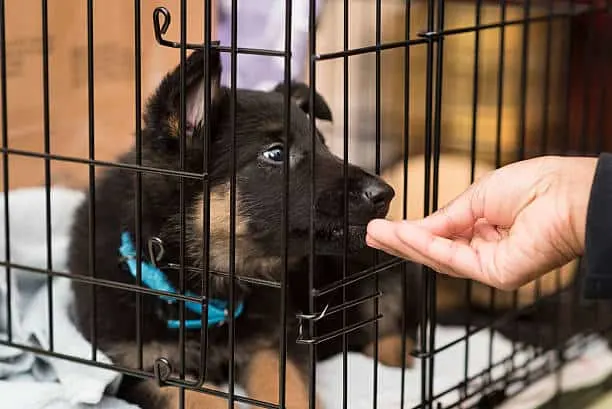
What To Do When the Crate Whining Just Won’t Stop
Sometimes, no matter what you try and how well it may have worked for other dogs, your German Shepherd puppy may not stop crying and whining.
What should you do if this happens?
The first thing to do is to talk with your dog’s vet.
It is always wise to have your new GSD puppy checked out by your veterinarian right away anyway — ideally, in the first 24 to 48 hours.
While some amount of crate whining and crying is normal, there might be different reasons for your dog’s whining behavior.
If your puppy keeps whining and crying, there may be something you missed. For example, your dog might be sick or injured and need treatment.
Puppies may also develop separation anxiety and get very frantic about trying to get out of their crate. When this happens, self-injury becomes possible.
By understanding the most common reasons your German Shepherd puppy might cry in their crate and what to do to ease loneliness and fears, your new puppy will soon settle into your family.
If you are looking to buy a new crate for your dog, here is a list of our recommendations.
Frequently Asked Questions
Why is my German Shepherd puppy crying in the crate?
There can be several reasons why your German Shepherd puppy is crying in the crate. It could be due to stress, anxiety, hunger, or even separation anxiety.
How can I help my German Shepherd puppy cry less in the crate?
Here are seven tips to help reduce your German Shepherd puppy’s crying in the crate:
– Make sure you are meeting their basic needs. Feed them properly and provide them with chew toys.
– Reward your puppy for good behavior in the crate, such as being calm and quiet.
– Spend time with your puppy outside of the crate to minimize boredom and frustration.
– Make sure you are using the crate correctly and consistently.
– Help your puppy get used to the crate by gradually increasing the duration of time they spend inside.
– Avoid punishing your puppy for crying in the crate, as it can increase anxiety and stress.
– Create a relaxing environment around the crate by using a comfy bed and soothing music.
Is it natural for a German Shepherd puppy to cry in the crate?
Yes, it is. Puppies are prone to cry in the crate, especially if they are not used to it. It takes time and patience to help them adjust to this new environment.
Why is it important to address my German Shepherd puppy’s crying in the crate?
Helping your German Shepherd puppy adjust to the crate can be critical in overcoming discomfort, anxiety, and stress. Ignoring it could lead to the development of separation anxiety and other behavioral issues.
How can I help my German Shepherd puppy get used to the crate?
You can help your German Shepherd puppy get used to the crate by gradually introducing them to it. Start by leaving the crate open and allowing them to explore it. Then, gradually encourage them to spend short periods of time inside with treats and praise.
Should I punish my German Shepherd puppy for crying in the crate?
No. Punishing your German Shepherd puppy for crying in the crate is not recommended. Punishment can increase their anxiety and stress, making the problem worse.
Instead, focus on positive reinforcement and creating a positive association with the crate.
My German Shepherd puppy cries in the crate at night. What should I do?
If your German Shepherd puppy cries in the crate at night, make sure you have met their basic needs before bedtime. Take them outside to relieve themselves, provide them with a comfortable sleeping area, and make sure they are not hungry. You can also place a blanket or t-shirt with your scent in the crate to provide comfort.
Can I leave my German Shepherd puppy in the crate for long periods?
Leaving your German Shepherd puppy in the crate for long periods of time is ill-advised. Puppies have limited bladder control and need to go outside frequently. Additionally, they require social interaction and mental stimulation.
If you need to leave your puppy for an extended period, consider using a dog sitter or daycare service.
Where can I purchase a crate for my German Shepherd puppy?
You can purchase crates for your German Shepherd puppy from pet stores, online retailers like Amazon, or local classifieds. It’s important to choose the appropriate size crate for your puppy’s current and future needs.
How can I reduce the crying in the crate when my German Shepherd puppy wants attention?
If your German Shepherd puppy cries in the crate to get your attention, you can try the following:
– Minimize the attention they receive when they cry. Wait for a moment of silence before rewarding them with attention.
– Teach them a “quiet” or “settle” command and reward them for being calm and quiet in the crate.
– Take them outside to go potty before putting them in the crate to minimize their discomfort from needing to go outside.
– Avoid giving in to their demands when they cry to prevent reinforcing the behavior.
























